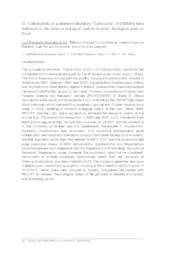Contributions of quarantine laboratory "Costa Lima" of EMBRAPA Meio Ambiente to the classical biological control of exotic Eucalyptus pests in Brazil.
Contributions of quarantine laboratory "Costa Lima" of EMBRAPA Meio Ambiente to the classical biological control of exotic Eucalyptus pests in Brazil.
Autoria: SA, L. A. N. de; PESSOA, M. C. P. Y.; WILCKEN, C. F.; JUNQUEIRA, L. R.; LAWSON, S. A.
Resumo: The quarantine laboratory ?Costa Lima? (LQCL) of Embrapa Meio Ambiente has contributed to the classical biological control of several exotic forest pests in Brazil. The first of these was the red gum lerp psyllid, Glycaspis brimblecombei, present in Brazil since 2003. Between 2004 and 2006, the parasitoid Psyllaephagus bliteus was imported from three distinct regions in Mexico, sourced from Comisión Nacional Florestal (CONAFLOR), as part of the Forest Protection Cooperative Program from Forestry Science and Research Institute (PROTEF/IPEF) of Brazil. P. bliteus populations were reared and multiplied by LQCL and later by the UNESP (São Paulo State University) which released the parasitoid in plantations. Further releases were made in 2006, resulting in effective biological control of this pest. Since 2008, PROTEF and the LQCL have successfully achieved the biological control of the bronze bug, Thaumastocoris peregrinus. In 2009 and 2010, LQCL introduced from Australia the egg parasitoid, Cleruchoides noackae, for UNESP, with the assistance of the University of Sydney and the Queensland Department of Employment, Economic Development and Innovation. This parasitoid demonstrated great multiplication and dispersion potential in eucalypt plantations throughout the country. Another Australian exotic pest that entered Brazil in 2007 was the eucalyptus gall wasp Leptocybe invasa. In 2009, Aprostocetus, Quadrastichus and Megastigmus parasitoid species were requested from the Department of Entomology, Agricultural Research Organization, Israel. However, the importation could not be completed. Introduction of another parasitoid, Selitrichodes neseri from the University of Pretoria, South Africa, was then initiated in 2015. This biological agent has also been multiplied post release from quarantine, resulting in the production of 8,615 adults in 2016/2017, which were later shipped to forestry companies associated with PROTEF for release. The biological control of this gall wasp is currently in progress, with promising results.
Ano de publicação: 2018
Tipo de publicação: Resumo em anais e proceedings
Unidade: Embrapa Meio Ambiente
Palavras-chave: Controle Biológico, Eucalipto, Psyllidae, Quarentena
Observações
1 - Por padrão são exibidas publicações dos últimos 20 anos. Para encontrar publicações mais antigas, configure o filtro ano de publicação, colocando o ano a partir do qual você deseja encontrar publicações. O filtro está na coluna da esquerda na busca acima.
2 - Para ler algumas publicações da Embrapa (apenas as que estão em formato ePub), é necessário ter, no celular ou computador, um desses softwares gratuitos. Sistemas Android: Google Play Livros; IOS: iBooks; Windows e Linux: software Calibre.
Acesse outras publicações
Acesse a Base de Dados da Pesquisa Agropecuária (BDPA) para consultar o acervo completo das bibliotecas da Embrapa.

